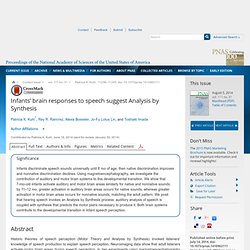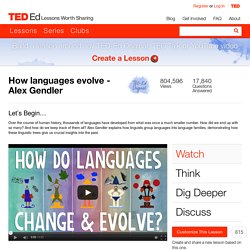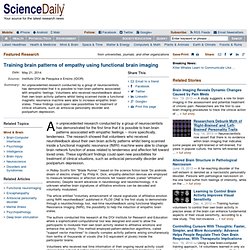

Reminding people of their religious belief system reduces hostility, study shows. Nature Reviews - Photos du journal. Kevin Slavin: How algorithms shape our world. Duetting musicians are linked by math. Musicians playing a duet don’t just make beautiful music—they make beautiful math.

A new study finds that as two players mesh, tiny hiccups in their rhythms follow repeating patterns. The study has implications for “humanizing” computer-generated music and helps reveal the complex mathematics underlying the common ways in which we interact. Study author Holger Hennig, a physicist at Harvard University, became interested in the mathematics of human rhythms while listening to the electronic drums in the song “Sexy Love” by Ne-Yo.
Animated map of Western culture traces movement of European historical figures. Still from YouTube This animated map, based on research by art historian Maximilian Schich and a team at the University of Texas at Dallas, traces the place of birth and death of more than 100,000 eminent figures in Western cultural history.

With births mapped in blue and deaths in red, it appears, as the narrator says, “a little like a map of budget airline destinations.” It’s more beautiful, however, than those pages at the back of Sky magazine. Burning Incense Is Psychoactive: New Class Of Antidepressants Might Be Right Under Our Noses. Religious leaders have contended for millennia that burning incense is good for the soul.

Now, biologists have learned that it is good for our brains too. An international team of scientists, including researchers from Johns Hopkins University and the Hebrew University in Jerusalem, describe how burning frankincense (resin from the Boswellia plant) activates poorly understood ion channels in the brain to alleviate anxiety or depression. This suggests that an entirely new class of depression and anxiety drugs might be right under our noses. Frans de Waal: Moral behavior in animals. Why do honeybees love hexagons? - Zack Patterson and Andy Peterson. Most Religious Places In The World Map. Fascinating psych experiments. Infants’ brain responses to speech suggest Analysis by Synthesis.
Author Affiliations Contributed by Patricia K.

Kuhl, June 16, 2014 (sent for review January 30, 2014) Significance. David Chalmers: How do you explain consciousness? Genetics and environment work together to help people become accomplished musicians, study finds. Mom or dad may have driven you to cello rehearsal all those years, but you can also thank your genes for pushing you to practice, according to new research led by a Michigan State University professor.

Genetics and environment work together to help people become accomplished musicians, finds the study of 850 sets of twins. It's another arrow in the quiver of the argument that both nature and nurture play a role in developing expertise. "The nature vs. nurture debate has raged since the beginning of psychology," said Zach Hambrick, MSU professor of psychology. "This makes it very clear that it's both. Dog Drinks Water In Slow Mo. Robert Turner - "The State of MRI" Steven Pinker: What our language habits reveal. How languages evolve - Alex Gendler. What is the difference between "a hearty welcome" and "a cordial reception"?

In a brief, action-packed history of the English language, Kate Gardoqui explains why these semantically equal phrases evoke such different images. Nature inspires drones of the future. Researchers have been taking tips from nature to build the next generation of flying robots.

Based on the mechanisms adopted by birds, bats, insects and snakes, 14 distinguished research teams have developed solutions to some of the common problems that drones could be faced with when navigating through an urban environment and performing novel tasks for the benefit of society. Whether this is avoiding obstacles, picking up and delivering items or improving the take-off and landing on tricky surfaces, it is hoped the solutions can lead to the deployment of drones in complex urban environments in a number of different ways, from military surveillance and search and rescue efforts to flying camera phones and reliable courier services.
For this, drones need exquisite flight control. Training brain patterns of empathy using functional brain imaging. An unprecedented research conducted by a group of neuroscientists has demonstrated for the first time that it is possible to train brain patterns associated with empathic feelings -- more specifically, tenderness.

The research showed that volunteers who received neurofeedback about their own brain activity patterns whilst being scanned inside a functional magnetic resonance (fMRI) machine were able to change brain network function of areas related to tenderness and affection felt toward loved ones. These significant findings could open new possibilities for treatment of clinical situations, such as antisocial personality disorder and postpartum depression. In Ridley Scott's film "Blade Runner," based on the science fiction book 'Do androids dream of electric sheep? ' by Philip K. Dick, empathy-detection devices are employed to measure tenderness or affection emotions felt toward others (called "affiliative" emotions). Altruism, egoism: Brain exercises cognitive analysis. Sociality, cooperation and "prosocial" behaviors are the foundation of human society (and of the extraordinary development of our brain) and yet, taken individually, people often show huge variation in terms of altruism/egoism, both among individuals and in the same individual at different moments in time.

Pregnant women respond to music with stronger physiological changes in blood pressure. Music can be soothing or stirring, it can make us dance or make us sad.

Blood pressure, heartbeat, respiration and even body temperature -- music affects the body in a variety of ways. It triggers especially powerful physical reactions in pregnant women. Scientists at the Max Planck Institute for Human Cognitive and Brain Sciences in Leipzig have discovered that pregnant women compared to their non-pregnant counterparts rate music as more intensely pleasant and unpleasant, associated with greater changes in blood pressure. Music appears to have an especially strong influence on pregnant women, a fact that may relate to a prenatal conditioning of the fetus to music. For their study, the Max Planck researchers played short musical sequences of 10 or 30 seconds' duration to female volunteers. The pregnant women rated the pieces of music slightly differently, they perceived the pleasant music as more pleasant and the unpleasant as more unpleasant.
10 fascinating facts about woolly mammoths. Sequencing an extinct genome is no longer a pipe dream, says evolutionary biologist and ancient DNA specialist Hendrik Poinar in today’s talk. It’s a modern reality, and we’re not too far from seeing a revived extinct species walking the Earth again — maybe even a woolly mammoth. In this talk from TEDxDeExtinction, Poinar talks about how he and fellow scientists are getting closer to completing a woolly mammoth genome, an intricate puzzle that consists of discovering, entangling and connecting over 5 billion base pairs. Hendrik Poinar: Bring back the woolly mammoth! So, why do we, humans, have such a fascination with woolly mammoths? “Woollys are a quintessential image of the Ice Age … We seem to have a deep connection with them as we do with elephants,” says Poinar in this sci-fi worthy talk.